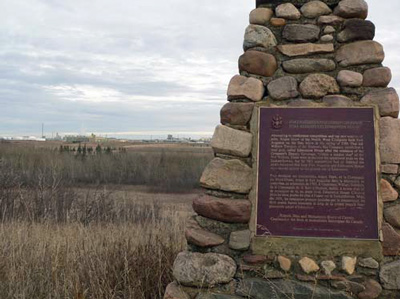Fort Augustus and Fort Edmonton National Historic Site of Canada
Lamoureux, Alberta

HSMBC cairn and plaque.
(© Parks Canada | Parcs Canada, 2011.)
Address :
Lamoureux Drive approximately 5.4 km from its intersection with Hwy 15, Lamoureux, Alberta
Recognition Statute:
Historic Sites and Monuments Act (R.S.C., 1985, c. H-4)
Designation Date:
1923-05-25
Dates:
-
1794 to 1795
(Construction)
-
1801 to 1801
(Significant)
Event, Person, Organization:
-
North West Company
(Organization)
-
Hudson’s Bay Company
(Organization)
Other Name(s):
-
Fort Augustus and Fort Edmonton
(Designation Name)
Research Report Number:
2009-SDC-CED-054, 1968-029
Plaque(s)
Existing plaque: Lamoureux Drive approximately 5.4 km from its intersection with Hwy 15, Alberta
Attempting to outdistance competition and tap new sources of pelts, Angus Shaw of the North West Company built Fort Augustus on the flats below in the spring of 1795. That fall William Tomison of the Hudson's Bay Company established a rival post, called Edmonton House after the residence of the Company's Deputy Governor, "within a musket shot" of the Nor'Westers. These were at the time the uppermost posts on the Saskatchewan, but by 1801 competition had so depleted the area's resources that both Fort Augustus and Edmonton House were moved upriver to the present site of Edmonton.
Description of Historic Place
Fort Augustus and Fort Edmonton National Historic Site of Canada is located on the north bank of the Saskatchewan River, 30 kilometres north-east of Edmonton, Alberta. The site is composed of two late-18th century forts: Fort Augustus, established by the North West Company from 1794 to 1795, and Fort Edmonton, established by the Hudson’s Bay Company in 1795. The forts sit almost immediately adjacent to each other in an open field beside the river, marked by a Historic Sites and Monuments Board of Canada plaque and cairn. There are no known above ground remains of either fort. Official recognition refers to a polygon enclosing the designated lot.
Heritage Value
Fort Augustus and Fort Edmonton was designated a national historic site of Canada in 1923. It is recognized because: Fort Augustus was established by the North West Company and Fort Edmonton by the Hudson’s Bay Company in 1795; and, Rivals in trade and allies in danger, these companies carried the flag and commerce of Britain by way of the great rivers from the shores of the Atlantic Ocean and Hudson Bay, to the Pacific and Arctic Oceans; Indigenous Peoples, their territories, and labour were foundational to the fur trade in North America. Posts were often built near existing Indigenous settlements, trading routes and/or meeting places and became important sites of economic, social and cultural exchange.
The North West Company founded Fort Augustus in 1794 or 1795 approximately 1.5 kilometres upstream from the confluence of the Sturgeon and Saskatchewan rivers. Fort Edmonton, originally called Edmonton House, was founded by the Hudson’s Bay Company in 1795 and is located almost immediately adjacent to the North West Company post. The North West Company and the Hudson’s Bay Company were drawn to this area in the late 18th century by the abundant fur resources along the river. The histories of Fort Augustus and Fort Edmonton are inextricably linked, as the two rival companies carried the flag and commerce of Britain by way of the great rivers from the shores of the Atlantic Ocean and Hudson Bay, to the Pacific and Arctic Oceans. After remaining at their North Saskatchewan River location for six years, the forts were abandoned in 1801 and moved approximately 30 kilometres upstream to what is now the city of Edmonton. After relocating several times, the final location of Fort Edmonton is designated as Fort Edmonton III National Historic Site of Canada on the grounds of the Alberta Legislature.
Source: Historic Sites and Monuments Board of Canada, Minutes, May 1926, December 2020; Status of Designation Committee Minutes, August 2009.
Character-Defining Elements
Key elements that contribute to the heritage character of the site include: - its location approximately 1.5 kilometres upstream from the confluence of the Sturgeon and Saskatchewan Rivers, near Fort Saskatchewan Alberta; - its setting in an open field on the north bank of the Saskatchewan River; - its historic and geographic relationship with Fort Edmonton III National Historic Site of Canada; - the integrity of any surviving or as yet unidentified archaeological remains relating to the two forts, which may be found within the site in their original placement and extent; - viewscapes from the site across the Saskatchewan River to open farmland.